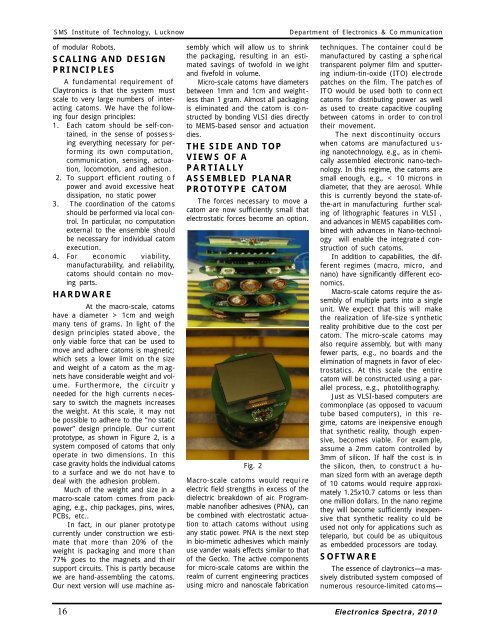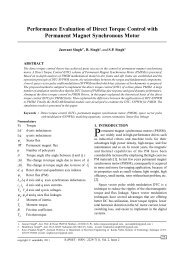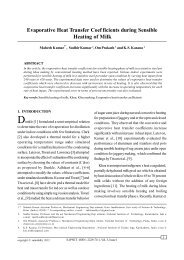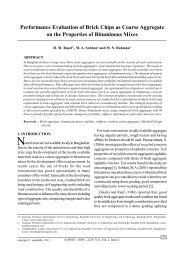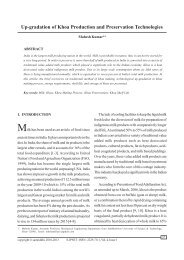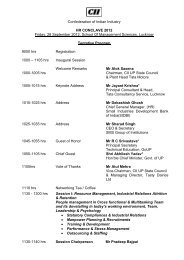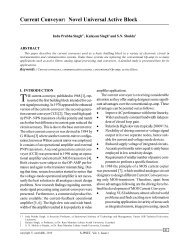Electronics Spectra - SMS Lucknow
Electronics Spectra - SMS Lucknow
Electronics Spectra - SMS Lucknow
Create successful ePaper yourself
Turn your PDF publications into a flip-book with our unique Google optimized e-Paper software.
<strong>SMS</strong> Institute of Technology, L ucknow<br />
Department of <strong>Electronics</strong> & Co mmunication<br />
of modular Robots.<br />
SCALING AND DESIGN<br />
PRINCIPLES<br />
A fundamental requirement of<br />
Claytronics is that the system must<br />
scale to very large numbers of interacting<br />
catoms. We have the fol lowing<br />
four design principles:<br />
1. Each catom should be self-contained,<br />
in the sense of posses s-<br />
ing everything necessary for performing<br />
its own computation,<br />
communication, sensing, actuation,<br />
locomotion, and adhesion.<br />
2. To support efficient routing o f<br />
power and avoid excessive heat<br />
dissipation, no static power<br />
3. The coordination of the catoms<br />
should be performed via local control.<br />
In particular, no computation<br />
external to the ensemble should<br />
be necessary for individual catom<br />
execution.<br />
4. For economic viability,<br />
manufacturability, and reliability,<br />
catoms should contain no moving<br />
parts.<br />
HARDWARE<br />
At the macro-scale, catoms<br />
have a diameter > 1cm and weigh<br />
many tens of grams. In light o f the<br />
design principles stated above , the<br />
only viable force that can be used to<br />
move and adhere catoms is magnetic;<br />
which sets a lower limit on th e size<br />
and weight of a catom as the m agnets<br />
have considerable weight and volume.<br />
Furthermore, the circuitr y<br />
needed for the high currents n ecessary<br />
to switch the magnets increases<br />
the weight. At this scale, it may not<br />
be possible to adhere to the “no static<br />
power” design principle. Our current<br />
prototype, as shown in Figure 2, is a<br />
system composed of catoms that only<br />
operate in two dimensions. In this<br />
case gravity holds the individual catoms<br />
to a surface and we do not hav e to<br />
deal with the adhesion problem.<br />
Much of the weight and size in a<br />
macro-scale catom comes from packaging,<br />
e.g., chip packages, pins, wires,<br />
PCBs, etc..<br />
In fact, in our planer prototy pe<br />
currently under construction we estimate<br />
that more than 20% of the<br />
weight is packaging and more t han<br />
77% goes to the magnets and th eir<br />
support circuits. This is partly because<br />
we are hand-assembling the catoms.<br />
Our next version will use machine assembly<br />
which will allow us to shrink<br />
the packaging, resulting in an estimated<br />
savings of twofold in we ight<br />
and fivefold in volume.<br />
Micro-scale catoms have diameters<br />
between 1mm and 1cm and weightless<br />
than 1 gram. Almost all packaging<br />
is eliminated and the catom is co n-<br />
structed by bonding VLSI dies directly<br />
to MEMS-based sensor and actuation<br />
dies.<br />
THE SIDE AND TOP<br />
VIEWS OF A<br />
PARTIALLY<br />
ASSEMBLED PLANAR<br />
PROTOTYPE CATOM<br />
The forces necessary to move a<br />
catom are now sufficiently small that<br />
electrostatic forces become an option.<br />
Fig. 2<br />
Macro-scale catoms would requi re<br />
electric field strengths in excess of the<br />
dielectric breakdown of air. Programmable<br />
nanofiber adhesives (PNA), can<br />
be combined with electrostatic actuation<br />
to attach catoms without using<br />
any static power. PNA is the next step<br />
in bio-mimetic adhesives which mainly<br />
use vander waals effects similar to that<br />
of the Gecko. The active components<br />
for micro-scale catoms are within the<br />
realm of current engineering practices<br />
using micro and nanoscale fabrication<br />
techniques. The container coul d be<br />
manufactured by casting a sphe rical<br />
transparent polymer film and sputtering<br />
indium-tin-oxide (ITO) ele ctrode<br />
patches on the film. The patch es of<br />
ITO would be used both to conn ect<br />
catoms for distributing power as well<br />
as used to create capacitive coupling<br />
between catoms in order to con trol<br />
their movement.<br />
The next discontinuity occurs<br />
when catoms are manufactured u s-<br />
ing nanotechnology, e.g., as in chemically<br />
assembled electronic nano-technology.<br />
In this regime, the catoms are<br />
small enough, e.g., < 10 microns in<br />
diameter, that they are aerosol. While<br />
this is currently beyond the state-ofthe-art<br />
in manufacturing further scaling<br />
of lithographic features in VLSI ,<br />
and advances in MEMS capabilities combined<br />
with advances in Nano-technology<br />
will enable the integrate d construction<br />
of such catoms.<br />
In addition to capabilities, the different<br />
regimes (macro, micro, and<br />
nano) have significantly different economics.<br />
Macro-scale catoms require the assembly<br />
of multiple parts into a single<br />
unit. We expect that this will make<br />
the realization of life-size s ynthetic<br />
reality prohibitive due to the cost per<br />
catom. The micro-scale catoms may<br />
also require assembly, but with many<br />
fewer parts, e.g., no boards and the<br />
elimination of magnets in favor of electrostatics.<br />
At this scale the entire<br />
catom will be constructed using a parallel<br />
process, e.g., photolithography.<br />
Just as VLSI-based computers are<br />
commonplace (as opposed to vacuum<br />
tube based computers), in this regime,<br />
catoms are inexpensive enough<br />
that synthetic reality, though expensive,<br />
becomes viable. For exam ple,<br />
assume a 2mm catom controlled by<br />
3mm of silicon. If half the cost is in<br />
the silicon, then, to construc t a human<br />
sized form with an average depth<br />
of 10 catoms would require app roximately<br />
1.25x10.7 catoms or less than<br />
one million dollars. In the nano regime<br />
they will become sufficiently inexpensive<br />
that synthetic reality co uld be<br />
used not only for applications such as<br />
telepario, but could be as ubiquitous<br />
as embedded processors are today.<br />
SOFTWARE<br />
The essence of claytronics—a massively<br />
distributed system composed of<br />
numerous resource-limited catoms—<br />
16 <strong>Electronics</strong> <strong>Spectra</strong>, 2010


